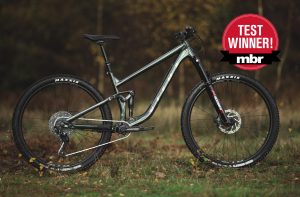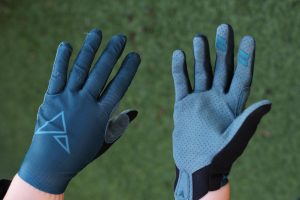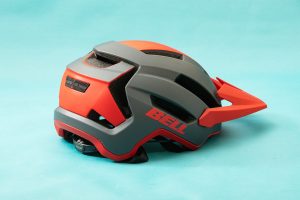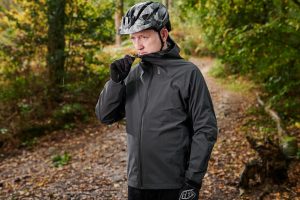Fancy yourself a bit of Strava competition, or just looking for a guide on where to ride? Well, it all comes down to using a good GPS unit; these are the best mountain bike computers to keep you on track.
If you’re a fan of a physical map and know how to take a bearing, that’s pretty awesome, but tricky navigation or structured training plans can call for some digital assistance. The best mountain bike GPS trackers are feature rich with digital mapping, performance measurements, terrain details and more. The ease of use and the amount of details that the device can display are what make it more mountain bike friendly.

Garmin Edge 530
Feature rich mountain bike computer at an affordable price.
Display: 2.6 inch colour display with 246×322 pixels resolution | Weight: 75.8g | Battery: Rechargeable (micro USB) Lithium ion with 20 hour-rated life | Dimensions: 82 x 50 x 20 mm | Rating: 8/10
Pros: Mapping is clear and simple, new, faster processor, mtb-friendly features
Cons: Fiddly to set up, map browsing is a button-pressing marathon
With all the advanced features but without a touch screen, Garmin Edge 530 sits between Edge 130 and Edge 830. Battery life is around 20 hours in standard operation and can be doubled in battery-saving mode. There’s also an option to buy a Garmin battery pack add-on which promises more than double the battery life again for the more remote rides.
Whilst being smaller than the likes of Hammerhead Karoo, the display is crisp and clear, even in low light conditions with backlight turned off thanks to the 246×322 pixel display. The out-of-box setup might be slightly time consuming, but otherwise, Garmin Edge 530 is pretty much ‘set and forget’ in its application, which bodes well for the users.
The mapping has improved from Edge 520 Plus and is fast and simple to use. Turn-by-turn navigation is available up to street level on the device and like previous Edge models, you can route-to-start, use the color-coded map and the audio cues for simple, wrong-turn-free navigation. The lack of touchscreen does mean a lot of button presses for map browsing but you get used to it pretty quickly.
Bike Alarm feature ensures that your bike doesn’t go missing when you’re out of the line of sight from your bike by sounding a loud alarm to notify you if any movement is detected, along with a phone notification.
A few really interesting MTB relevant features include ClimbPro, Find My Edge and measurements of Grit and Flow. ClimbPro warns about any upcoming climbs, along with its key metrics like distance, gradient, ascent, etc. Mid-climb, you’ll be notified with what’s left ahead of you. Find My Edge helps find the device in case you lose it mid-descent or in a crash with the help of an alarm, as well as with exact coordinates of where the bluetooth connection was lost so that you can be redirected to that point. Grit is the level of difficulty of the course you’re riding and Flow measures how well you did it. Garmin’s advanced accelerometers can even give you a good measurement of your hang time, jump distance and jump count.
Aside from any reservations that you might have about the non-touchscreen setup, Garmin Edge 530 is feature-rich, affordable and easy to use.

Garmin Fenix 6 Pro Solar Edition smart watch
Highly functional, accurate and reliable GPS device
Weight: 85g | Case sizes: 42mm, 47mm, 51mm | Rating: 8/10
Pros: Wealth of features at your forearm, display is big and clear, while the case is small and snug meaning it’s a comfy fit, great GPS accuracy, one of the best heart rate monitors out there.
Cons: Overly complicated for most riders, Solar edition is perhaps less than useful in the UK
Jam-packed activity features on a tiny screen with multi-sport compatibility and a high price tag means that Garmin Fenix 6 Pro is one of the high end GPS devices. There’s a lot of choice available in terms of how you don this device- six sizes, three spec levels, multiple colors and strap options.
Out of the impossibly long list of features, the ride-relevant ones are the heart rate information, breathing rate, blood oxygen saturation, training data, ascent information, reliable turn-by-turn navigation and auto synchronization with any external apps that you might want to upload your data to.
You can map your heart rate throughout any ride using the watch itself or a bluetooth connected chest strap. That, combined with other factors and a smart algorithm will tell you your training load score, and how many hours worth rest you need. You can also see your Training Effect from each ride, telling you if you’ve increased your VO2 max, boosted muscular endurance, base fitness or high aerobic capacity. According to this, Fenix 6 will also recommend different types of rides to give you a more rounded training.
The GPS mapping is extremely accurate, and getting a bar mount can make on-the-go navigation super easy. Of course, if you don’t have a chest strap to monitor your heart rate, putting your watch on the bar mount won’t include your heart rate statistics anymore.
The Pro Solar function offers solar charging, but it’s more of a battery top up than a full on charging setup. Ideally, the battery should last for about 6 days before you need to charge it.
If you’re into the detailed ride stats and in general want to use a device for multiple sports than just mountain biking, this device is great for that. It sure is a high-end device with a huge price tag though!
Read the full review of the Garmin Fenix 6 Pro Solar Edition smart watch

Hammerhead Karoo 2 GPS computer
Rich interface, comprehensive data and solid connectivity
Dimensions: 100.6 x 60.8 x 19.3mm | Weight: 135g actual | Claimed battery life: 12-hours | Color touchscreen: Yes | Screen size: 3.2in / 82mm diagonal | Rating: 8/10
Pros: Usefully detailed mapping, excellent screen, intuitive to use, comprehensive data/functions, touchscreen and button control, Garmin adaptor included, regular feature/software updating
Cons: Separate recharge port plug, no smartphone control, no AXS sync yet, Training Peaks workouts only, pricy
With the feel of using a mobile phone as a GPS computer without actually using your phone, Hammerhead Karoo 2 is an intuitive device with excellent colour display. There’s no smartphone app to go with the device, making it only usable with certain third party apps.
Karoo 2 has a 82mm colour screen behind toughened Dragontrail glass. The touchscreen device with four buttons along the sides has a battery life of 9-13 hours depending on the features you are using. In spite of the whole host of sensors that the Karoo 2 is compatible with, you can’t connect it to the SRAM AXS ecosystem. It is compatible with Di2 though. Also, it can only import workouts from Training Peaks, which isn’t particularly a deal breaker, but sure, more compatibility with other apps would be nice!
All of the setup has to be done from the device itself, and you can even add a SIM card into it if you don’t want to piggyback off of your phone’s hotspot.
The device interface is rich in colours and feature rich. It is one of the easiest and most enjoyable GPS computers to use but the lack of MTB-specific features might be a deal breaker, if that’s what you’re after.
How we tested
The GPS units on this list have been evaluated and reviewed by an expert team of mountain bike product testers. They look for elements such as usability, battery life, how easy it is to operate controls while wearing gloves, screen display options and available metrics such as speed and heartrate.
How to find the best GPS computer for mountain biking
There are lots of different compact GPS computers on the market, so what should you be looking for?

Which is the best MTB GPS computer for me?
Cycling GPS computers come with a wide variety of functionalities, and what you need completely depends on the aim of your riding. If you’re planning on using the device for multiple sports, then you’ll need to invest in something feature-rich and adaptable like Garmin Fenix 6 Pro Solar. If you’re looking for something to just log the basic metrics of your ride then something like Garmin Edge 25 should suffice. If you need all the data in the world and more then Hammerhead Karoo 2 or Garmin Edge 530 would work well.
Ideally, once you know what you’re going to use the device for, think about the features the devices come with. Do they offer accurate GPS mapping? Is the device compatible with the other sports tech that you use? Are you going to need to know the MTB specific stats like grit, flow, hang time, etc? Battery life is another important thing to consider, if you’re into the endurance side of off road riding.
What to look for in a GPS computer for mountain biking
1. Handlebar, stem or wrist-mounted
The majority of bike-specific GPS computers are small units that come with a range of mounts that allows you to attach them to your handlebars, stem or top cap. There are also after-market attachments available to give a wider range of cockpit positions. If you’re more into multisports or prefer to have your tracker on your person, you might prefer to opt for a watch-style wrist GPS device.
2. Mapping and base maps
Most GPS computers will require you to download base maps on which your route will be displayed. There are often available in a bundle when you buy your device. For mountain biking, look for more off-road focussed base maps which will often be to a larger scale to allow for more detailed routes.
3. Functionality and metrics
Most GPS units will provide turn-by-turn or map-based navigation, plus metrics such as speed and elapsed time. If you want something less basic, you’ll be able to find GPS units that will tell you your heart rate, which heart rate zone you’re riding in, guide you through workouts, give you your cadence and power output, and even tell you your flow levels and how much time you spent in the air aka hangtime.
4. Screen options
The screens on GPS units vary massively, and often also by price. Cheaper units will tend to have smaller black and white screens, with button-operated functions. Pricier ones are often touch screen enabled with colour displays. Size varies too. Think about what you want to use it for, what your priorities are, and what will work best for you. Some people like large, easier to read screens with great colour contrast, and for others the priority will be simple controls and longer battery life.
5. App and mapping compatibility
Want to use your GPS unit with Strava, Map My Ride or similar app or mapping software? Make sure you check compatibility. Many GPS units will work with several different apps, and many also have their own mapping system if you prefer to use that.
6. Heartrate monitors and other sensors
If you’re looking to get accurate measures on your exertion levels or power output, look for a GPS unit that works with data sources from different sensors. This might be heart rate monitors or power meters. Some units come in bundles with chest-mounted heart rate monitors.
7. Battery life
If you’re mostly looking for something to help you navigate on shorter rides, battery life won’t be a massive concern. If, on the other hand, you’re heading out into the wild for hours or days at a time, it becomes a whole lot more critical. Things like colour screens can often drain batteries more quickly.
Is a cycling GPS worth it?
Absolutely! Knowing the details of your ride will help you figure out what does and doesn’t work out well for when it comes to riding. Turn by turn navigation is a huge plus and saves your phone battery when you’re trying to follow a strict path. The auto-upload features in GPS devices are great for uploading your ride data to multiple third party apps like Training Peaks, Strava, etc. You can even follow a certain training plan using these devices. All in all, GPS computers help you know yourself and your riding capabilities better and help you improve.


















